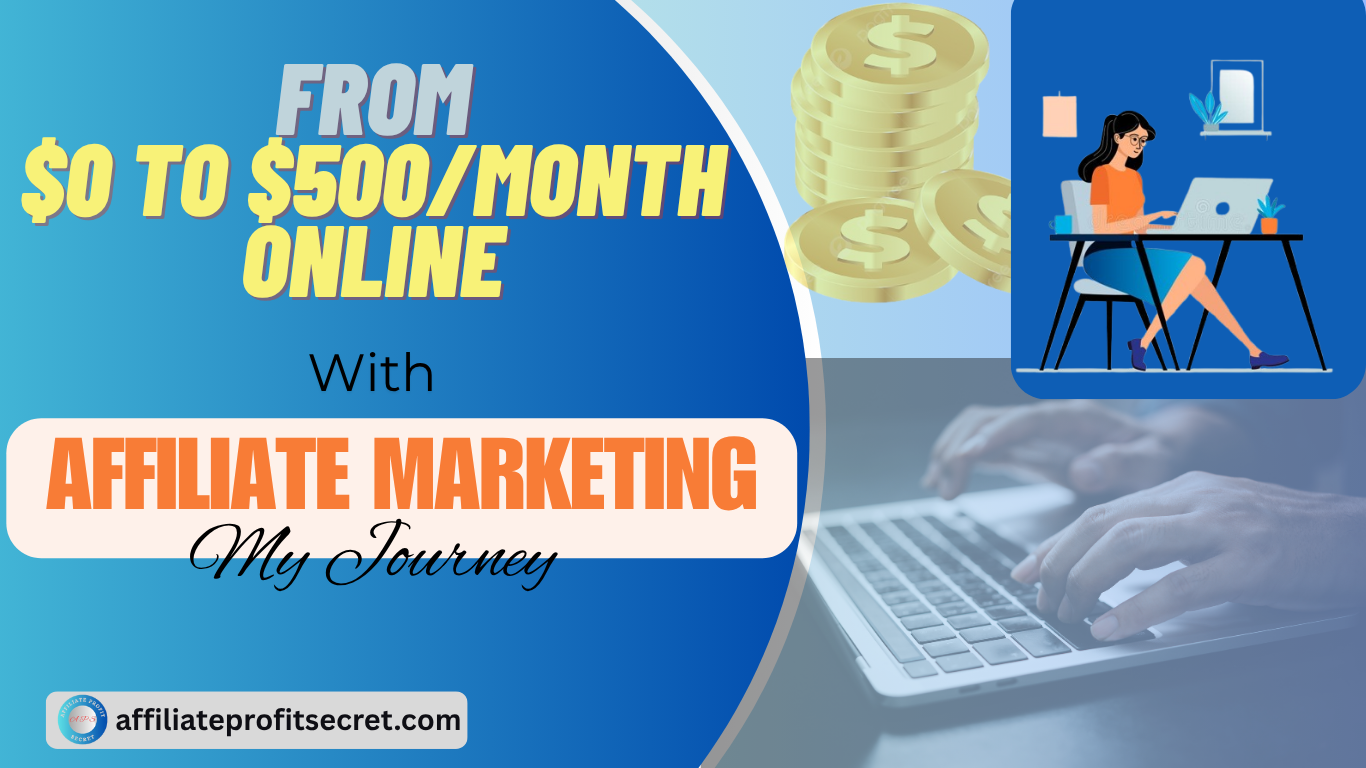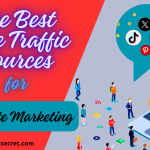Welcome to my article on “From $0 to $500/Month Online With Affiliate Marketing: My Journey”. Not long ago, I was the person googling “how to make money online without selling my soul (or kidneys).” After hours of falling down internet rabbit holes filled with sketchy side hustles and YouTube gurus promising Lamborghinis in 3 weeks, one phrase kept popping up: affiliate marketing. It sounded fancy, a little mysterious, and—most importantly—didn’t require me to create a product, store inventory, or harass my friends into buying detox tea.
So, with zero experience and a laptop that wheezed louder than my coffee machine, I decided to give it a shot. My goal? Make $500 per month. Nothing too wild—just enough to cover groceries, streaming subscriptions, and the occasional impulse purchase on Amazon that I’d later regret. In this post, I’ll walk you through exactly how I went from $0 to $500/month with affiliate marketing—from picking the right niche and platform to writing content that doesn’t make readers want to run for the hills. If you’ve ever wondered whether affiliate marketing is legit or just another internet pipe dream, this is the no-BS guide I wish I had when I started. Let’s dive in—no fluff, no funnels, and definitely no Lambos.
My Best Recommended & Proven Way to Make $100-$300 Daily – Watch This FREE Video to START >>>

Picking the Right Niche and Affiliate Programs (Without Overthinking Yourself Into a Coma)
When I first heard “pick a niche,” I thought, “Easy! I’ll just talk about everything I like.” Turns out, that’s the opposite of picking a niche. It’s called having a personality. In affiliate marketing, focus wins—and by “focus,” I mean finding a topic you can create a ton of content around without wanting to stab your eyeballs out from boredom.
Here’s the golden rule I wish someone had engraved on a mug for me:
Your niche should live at the intersection of interest, profitability, and content potential.
Let me break it down:
- Interest: You don’t need to be a “passion-fueled expert,” but you should enjoy the topic enough to keep talking about it without crying. For me, that meant skipping crypto (too confusing) and fitness (because I’d rather eat nachos than count macros).
- Profitability: Some niches pay peanuts, others pay rent. Look for affiliate programs with solid commissions. Tech, software, finance, and digital tools tend to offer the highest payouts. Spoiler: Amazon Associates is great for beginners, but unless you’re sending thousands of clicks, your earnings might look like pocket change.
- Content Potential: If there are only three things to say about your niche, you’re setting yourself up for a short and painful blogging career. Pick something you can write guides, reviews, comparisons, and listicles about for months.
Once I landed on my niche (tools and resources for online creators), I started shopping for affiliate programs like it was Black Friday. Some of the platforms I used:
- Amazon Associates – Super easy to join, but commission rates are… let’s say “modest.”
- ShareASale – A great place to discover high-paying affiliate programs across many niches.
- Impact and CJ – Slightly more advanced, but worth it for quality brands and dashboards that don’t look like they were coded in 1998.
One key lesson: don’t join 30 programs just because you can. Start with 2–3 that truly align with your content and audience. Focus = faster results.
Picking a niche and affiliate program isn’t the most glamorous part of the process—but get this right, and the rest of your journey gets a whole lot smoother. Now, on to actually building a platform to promote this stuff without sounding like a walking ad…
Building a Platform – Blog, YouTube, or Social Media (aka: Where Do I Put All These Affiliate Links?)
Okay, so you’ve picked your niche. You’ve signed up for a few affiliate programs. You’re pumped. You’re ready. But now you’re staring at your screen like, “Umm… where exactly do I put these links?”
Welcome to The Platform Dilemma™—a rite of passage in every affiliate marketer’s journey. Should you start a blog? Launch a YouTube channel? Become TikTok famous overnight? (Spoiler: you won’t, but points for optimism.)
Let’s break down the big three:
1. Blogging: The Evergreen Empire
Blogging is like the golden retriever of affiliate marketing platforms: loyal, dependable, and it takes a bit of training upfront. If you enjoy writing and aren’t terrified of Google (just mildly intimidated like the rest of us), this is a fantastic option.
I personally chose blogging because:
- It’s searchable. Your content can rank on Google and bring in traffic for years.
- You can target buyer-intent keywords like “best [product] for beginners.”
- It doesn’t require perfect lighting, a ring light, or pretending to be enthusiastic on camera.
Pro tip: Set up a simple WordPress site with fast hosting (I used SiteGround), install an SEO plugin (like Rank Math or Yoast), and start creating helpful, honest content. Think reviews, tutorials, comparisons, and “top 10” posts. Google eats that stuff up.
2. YouTube: Face the Camera, Reap the Clicks
If you’re comfortable talking on camera—or at least faking it until you are—YouTube can be a goldmine. Videos like “How to Use [Tool]” or “Is [Product] Worth It?” perform really well, and affiliate links in the description box? Chef’s kiss.
My Best Recommended & Proven Way to Make $100-$300 Daily – Watch This FREE Video to START >>>
Bonus: YouTube videos also rank on Google, so you’re doubling your visibility. Just be ready to spend time editing, dodging copyright music, and explaining to your neighbor why you’re talking to yourself in front of a ring light again.
3. Social Media: Fast but Fickle
Social platforms like TikTok, Instagram, and Pinterest can drive quick bursts of traffic if you catch a trend, but they’re more like roller coasters—fun and exciting, but not always reliable. Algorithms change more often than my coffee order, and posts have a short lifespan unless they go viral.
Still, don’t sleep on them:
- Pinterest is great for blog traffic.
- TikTok can blow up a product review overnight.
- Instagram reels with strong CTAs can lead to decent affiliate clicks.
Just make sure your content actually provides value—no one wants to be sold to by a dancing influencer holding a protein shaker.
Creating Content That Converts (aka: How Not to Sound Like a Desperate Salesperson)
Now that you’ve got your niche, affiliate links, and a platform that doesn’t look like it was built during the MySpace era, it’s time for the main event: content that actually makes people click—and maybe even buy.
So how do you create content that actually converts without sounding like you’re just there to sell stuff? Here’s the secret sauce (no gatekeeping, I promise):
1. Be Helpful First, Promotional Second
People aren’t Googling “top 10 keyboards for productivity” because they want to read fluff—they’re ready to make a decision, and they want someone (you) to help them make the right call. Your job? Be the honest friend who’s tried the product, not the pushy salesperson in aisle five.
Break down:
- Pros and cons (yes, include the cons—it builds trust)
- Who the product is for (and who it’s not for)
- Your own experience using it (even if it was awkward)
The more value and clarity you provide, the more likely someone will click that link out of genuine trust—and curiosity.
2. Master the “Affiliate Content Trio”
There are three types of affiliate content that consistently perform well:
- Product Reviews – Share your honest experience. Even better if you include photos, screenshots, or videos.
- Comparison Posts – “[Tool A] vs. [Tool B]: Which One’s Worth Your Money?” These do incredibly well because people are literally in decision mode.
- Best-of Lists – Everyone loves a good roundup: “10 Best Budget Laptops for Students” or “Top 5 Email Marketing Tools for Beginners.”
Bonus tip: Use strong, specific titles. “My Honest Review of the XYZ Productivity App (After 30 Days)” will beat “Review of XYZ App” any day.
3. Sprinkle in Keywords Like You’re Seasoning a Steak
I’m not saying become an SEO wizard overnight, but some light keyword research goes a long way. Use free tools like Google’s “People Also Ask” box, Ubersuggest, or even just the autocomplete bar.
Find terms people are already searching, and write content that answers those questions. Don’t stuff keywords in like you’re trying to win Scrabble—just be natural. Google’s smart (sometimes too smart).
4. Make Clicking Easy (But Not Desperate)
Once your reader is nodding along, make it simple for them to take action. Use clear, honest call-to-actions like:
- ✅ “Check the latest price on Amazon”
- 🎯 “Try [Product] free for 7 days”
- 🔗 “Read more about [Tool] here”
Use buttons or bold links. No one should have to hunt for your affiliate links like they’re buried treasure.
Scaling Up to $500/Month and Lessons Learned
Ah yes—scaling up. That magical phrase affiliate marketers toss around like fairy dust. But here’s the thing: going from $0 to your first few affiliate clicks is exciting. Going from a few bucks to consistent $500/month? That’s where the real work (and learning curve) lives.
It wasn’t a straight line. It looked more like a toddler’s crayon drawing—chaotic, weirdly shaped, and full of “what the heck is happening” moments. But eventually, I found my groove. Here’s how I scaled—and what I wish I knew sooner.
1. More Content = More Chances to Be Found
Once I saw my first commission (a glorious $2.37), I celebrated like I won the lottery and then did the logical thing: I doubled down. I focused on publishing more high-quality content that followed what was already working.
My Best Recommended & Proven Way to Make $100-$300 Daily – Watch This FREE Video to START >>>
That meant:
- Doubling up on comparison posts (they convert like crazy).
- Updating old content with better CTAs and fresh info.
- Repurposing blog posts into Pinterest pins and short videos for extra reach.
Google and your audience both love consistency. More content = more eyeballs = more clicks = more money. Not rocket science, but definitely effort.
2. Analytics Are Boring, But Also Magical
I started checking which pages were actually bringing in clicks and commissions. Spoiler: it wasn’t always the posts I thought were the winners. One random tutorial I almost didn’t publish ended up generating a chunk of monthly income.
Lesson? Let the data talk. Use Google Analytics and your affiliate dashboards to track what’s performing, then rinse and repeat. Also: stop obsessively refreshing your stats every 30 minutes. That’s not scaling, that’s anxiety with Wi-Fi.
3. Diversify, But Don’t Dilute
After hitting around $200/month consistently, I started experimenting with new affiliate programs and higher-ticket items. It’s tempting to join every program under the sun once you see money trickling in—but resist the urge to go full coupon-clipping mode.
I stuck to products I actually liked and used. Why? Because fake enthusiasm is exhausting. Plus, your audience can smell desperation (and sponsored insincerity) from a mile away.
4. The Real Secret: Patience + Persistence
I know, I know—not the sexy answer. But here’s the honest truth: most people don’t fail at affiliate marketing because it’s “too hard.” They fail because they stop after 3 blog posts and zero sales.
Getting to $500/month took me months of trial, error, tweaking, learning, and a small existential crisis or two. But it did happen. And now that I’ve built the foundation, scaling beyond that gets easier—because the content keeps working for me, 24/7, even when I’m binge-watching Netflix.
Final Thought: You Don’t Need to Be a Genius—Just Relentlessly Consistent
Affiliate marketing isn’t a get-rich-quick scheme—it’s a build-slow-grow-smart game. If you’re willing to play it with patience, creativity, and just enough stubbornness to keep going after the first flop, $500/month is totally doable.
And trust me—when that first payout hits your bank account, it feels like sweet, sweet validation (and maybe also pizza money).
Conclusion: Can You Do It Too? (Spoiler: Yes, You Absolutely Can)
So, after all this talk about niches, content, scaling, and mild existential dread—here’s the million-dollar (or $500-a-month) question: Can you do this too?
The short answer? Heck yes.
The long answer? Yes—but only if you’re willing to play the long game.
I didn’t have a marketing degree, a tech background, or a magical unicorn whispering blog post ideas into my ear. I started with a $3.95/month hosting plan, a stubborn attitude, and a vague belief that maybe, just maybe, I could make affiliate marketing work.
And slowly, it did.
The beauty of affiliate marketing is that it doesn’t require a massive budget, fancy software, or a million followers. What it does require is consistency, honesty, and the ability to write (or talk) like a real human who’s genuinely trying to help. If you can do that—and you’re cool with not becoming an overnight success—you’re already ahead of 90% of the people who quit after two weeks.
My Best Recommended & Proven Way to Make $100-$300 Daily – Watch This FREE Video to START >>>
Here’s what I recommend:
- Start small, start messy, but start.
- Pick one platform and get good at it before trying five.
- Treat your first few commissions like proof—not payment.
- Celebrate the little wins (yes, even the $0.87 ones).
Affiliate marketing won’t make you rich by tomorrow, but it can build a solid stream of passive(ish) income that grows over time. And if a former internet-scroller like me can go from zero to $500/month, there’s no reason you can’t do it too—preferably with fewer awkward mistakes. So go forth, pick your niche, build your platform, and start creating. The sooner you start, the sooner you’ll have your “first commission dance” moment. Trust me, it’s worth it.
Thanks a lot for reading my article on “From $0 to $500/Month Online With Affiliate Marketing: My Journey” till the end. Hope you’ve helped. See you with another article.










